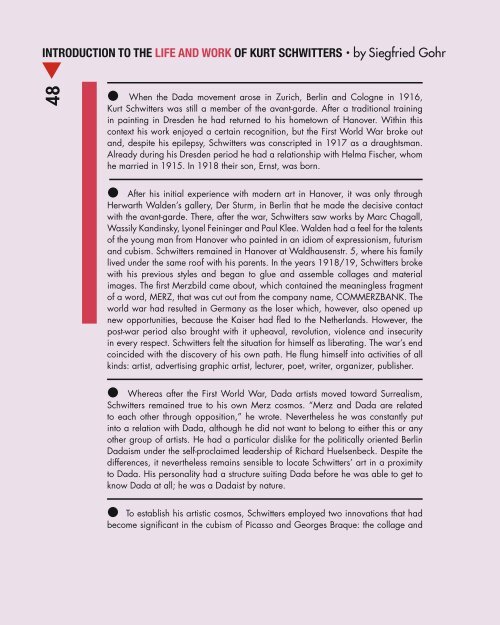Kurt Schwitters: Merz (2016) – Norman Rosenthal interviews Damien Hirst
Fully illustrated catalog published by Galerie Gmurzynska in collaboration with Cabaret Voltaire Zurich on the occasion of Kurt Schwitters: MERZ, a major retrospective exhibition celebrating 100 years of Dada. The exhibition builds and expands on the gallery’s five decade long exhibition history with the artist, featuring exhibition architecture by Zaha Hadid. Edited by Krystyna Gmurzynska and Mathias Rastorfer. First of three planned volumes containing original writings by Kurt Schwitters, historical essays by Ernst Schwitters, Ad Reinhardt and Werner Schmalenbach as well as text contributions by Siegfried Gohr, Adrian Notz, Jonathan Fineberg, Karin Orchard, and Flavin Judd. Foreword by Krystyna Gmurzynska and Mathias Rastorfer. Interview with Damien Hirst conducted by Norman Rosenthal. Includes full color plates and archival photographs. 174 pages, color and b/w illustrations. English. ISBN: 978-3-905792-33-1 The publication includes an Interview with Damien Hirst by Sir Norman Rosenthal about the importance of Kurt Schwitters's practice for Hirst's work.
Fully illustrated catalog published by Galerie Gmurzynska in collaboration with Cabaret Voltaire Zurich on the occasion of Kurt Schwitters: MERZ, a major retrospective exhibition celebrating 100 years of Dada. The exhibition builds and expands on the gallery’s five decade long exhibition history with the artist, featuring exhibition architecture by Zaha Hadid.
Edited by Krystyna Gmurzynska and Mathias Rastorfer.
First of three planned volumes containing original writings by Kurt Schwitters, historical essays by Ernst Schwitters, Ad Reinhardt and Werner Schmalenbach as well as text contributions by Siegfried Gohr, Adrian Notz, Jonathan Fineberg, Karin Orchard, and Flavin Judd.
Foreword by Krystyna Gmurzynska and Mathias Rastorfer.
Interview with Damien Hirst conducted by Norman Rosenthal.
Includes full color plates and archival photographs.
174 pages, color and b/w illustrations.
English.
ISBN:
978-3-905792-33-1
The publication includes an Interview with Damien Hirst by Sir Norman Rosenthal about the importance of Kurt Schwitters's practice for Hirst's work.
Create successful ePaper yourself
Turn your PDF publications into a flip-book with our unique Google optimized e-Paper software.
INTRODUCTION TO THE LIFE AND WORK OF KURT SCHWITTERS · by Siegfried Gohr<br />
t<br />
48<br />
•<br />
When the Dada movement arose in Zurich, Berlin and Cologne in 1916,<br />
<strong>Kurt</strong> <strong>Schwitters</strong> was still a member of the avant-garde. After a traditional training<br />
in painting in Dresden he had returned to his hometown of Hanover. Within this<br />
context his work enjoyed a certain recognition, but the First World War broke out<br />
and, despite his epilepsy, <strong>Schwitters</strong> was conscripted in 1917 as a draughtsman.<br />
Already during his Dresden period he had a relationship with Helma Fischer, whom<br />
he married in 1915. In 1918 their son, Ernst, was born.<br />
•<br />
After his initial experience with modern art in Hanover, it was only through<br />
Herwarth Walden’s gallery, Der Sturm, in Berlin that he made the decisive contact<br />
with the avant-garde. There, after the war, <strong>Schwitters</strong> saw works by Marc Chagall,<br />
Wassily Kandinsky, Lyonel Feininger and Paul Klee. Walden had a feel for the talents<br />
of the young man from Hanover who painted in an idiom of expressionism, futurism<br />
and cubism. <strong>Schwitters</strong> remained in Hanover at Waldhausenstr. 5, where his family<br />
lived under the same roof with his parents. In the years 1918/19, <strong>Schwitters</strong> broke<br />
with his previous styles and began to glue and assemble collages and material<br />
images. The first <strong>Merz</strong>bild came about, which contained the meaningless fragment<br />
of a word, MERZ, that was cut out from the company name, COMMERZBANK. The<br />
world war had resulted in Germany as the loser which, however, also opened up<br />
new opportunities, because the Kaiser had fled to the Netherlands. However, the<br />
post-war period also brought with it upheaval, revolution, violence and insecurity<br />
in every respect. <strong>Schwitters</strong> felt the situation for himself as liberating. The war’s end<br />
coincided with the discovery of his own path. He flung himself into activities of all<br />
kinds: artist, advertising graphic artist, lecturer, poet, writer, organizer, publisher.<br />
•<br />
Whereas after the First World War, Dada artists moved toward Surrealism,<br />
<strong>Schwitters</strong> remained true to his own <strong>Merz</strong> cosmos. “<strong>Merz</strong> and Dada are related<br />
to each other through opposition,” he wrote. Nevertheless he was constantly put<br />
into a relation with Dada, although he did not want to belong to either this or any<br />
other group of artists. He had a particular dislike for the politically oriented Berlin<br />
Dadaism under the self-proclaimed leadership of Richard Huelsenbeck. Despite the<br />
differences, it nevertheless remains sensible to locate <strong>Schwitters</strong>’ art in a proximity<br />
to Dada. His personality had a structure suiting Dada before he was able to get to<br />
know Dada at all; he was a Dadaist by nature.<br />
•<br />
To establish his artistic cosmos, <strong>Schwitters</strong> employed two innovations that had<br />
become significant in the cubism of Picasso and Georges Braque: the collage and

















